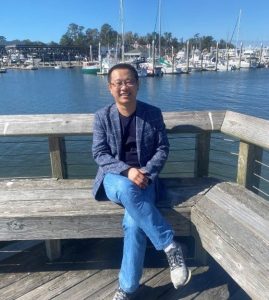Qisheng Zhang Laboratory
Qisheng Zhang Laboratory
Research in the Zhang lab is focused on understanding the roles of endogenous small molecules, particularly phospholipids, in cell signaling events that are responsible for both normal development and diseases. Phospholipids play essential roles in all living organisms. Other than being major membrane constituents in cells, many phospholipids function as signaling molecules. Consequently, abnormal levels of phospholipids and aberrant regulation of their metabolizing enzymes have been associated with onset and progression of various diseases. However, how phospholipid signaling pathways regulate normal development and diseases is still poorly understood, largely due to their dynamic metabolism in the cells and the lack of available reagents and assays for phospholipids and their metabolic enzymes. I am interested in three different approaches to profile and understand phospholipids: 1) Develop small molecule sensors and modulators for different phospholipid metabolizing enzymes; 2) Develop efficient methods and technologies to profile phospholipids and use the resulting data for precision medicine and identification of new signaling molecules; and 3) Investigate cellular functions of known and unknown phospholipids, particularly their synergistic actions with small GTPases ADP-ribosylation factors in regulating protein trafficking in signaling transduction. More recently, we have also extended our efforts to drug discovery towards diseases (particularly cancer and neurodegenerative diseases) where phospholipid metabolizing enzymes are dysregulated. Toward this end, we are constructing library of small molecules with unique structures and functions.
Phosphatidylinositides (PIs) are a family of anchoring lipids with different combinations of phosphate groups around the inositol ring. Due to their functions of membrane recruitment and activation of downstream effector proteins, PIs are among the most versatile endogenous regulatory small molecules. Dys-regulation of PI signaling has been implicated in diseases such as Low syndrome, cancer, and myotubular myopathy. We are generating an array of natural and unnatural PIs to systematically identify PI-interacting proteins for novel drug target discovery and disease diagnosis. To facilitate these processes, we are developing new technologies of tag-based enzymatic synthesis and target identification as well as small molecule arrays.
To understand the details on how PIs are regulated in living cells, we have developed fluorescence-based reporters for PI-metabolic enzymes PLC and PI3K. These reporters are then used to monitor PLC and PI3K activity in the cells, and further utilized in high throughput screen to identify small molecule inhibitors.
GTPase-activating proteins for the ADP-ribosylation factors (ARFGAPs) play important roles in many biological processes, including vesicle trafficking and cytoskeleton reorganization. We recently identified a small molecule ARFGAP inhibitor from a high throughput chemical screen of the Wnt signaling pathway. We are exploring the functions and mode of actions of this molecule in membrane trafficking, cell migration, and neurite
Peer Reviewed Publications
- Siraliev-Perez, E.; Hoffmann, R.; Stariha, J.; Temple, B. R.; Zhang, Q.; Hajicek, N.; Burke, J. E.; Sondek, J. Dynamics of allosteric regulation of the phospholipase C-g isozymes upon recruitment to membranes. eLife 2022, 11:e77809.
- Gallion, L. A.; Wang, Y.; Massaro, A.; Petersen, B. V.; Huang, W.; Zhang, Q.; Carr, A.; Zhang, Q.; Allbritton, N. L. “Fix and click” for assay of sphingolipid signaling in single primary human intestinal epithelial cells. Anal. Chem. 2022, 94, 1594-1600.
- Cook, B.; Walker, N.; Zhang, Q.; Chen, S.; Evans, T. The small molecule DIPQUO promotes osteogenic differentiation via inhibition of glycogen synthase kinase 3b signaling. J. Biol. Chem. 2021, 296, 100696. Doi: 10.1016/jbc.2021.100696.
- Carr, A. J.; Siraliev-Perez, E.; Huang, W.; Sondek, J.; Zhang, Q. Flourogenic XY-69 in lipid vesicles for measuring activity of phospholipase C isozymes. Methods Mol. Biol. 2021, 2251, 225-236.
- Morbitzer, K. A.; McLaughlin, J. E.; Ozawa, S.; Beechinor, R. J.; Dumond, J. B.; Pomykal, C.; Bush, A. A.; Zhang, Q.; Carpenter, D. M.; Lee, C. R. Implementation and initial evaluation of a research and scholarship training pathway in a PharmD curriculum. Am. J. Pharm. Educ. 2021, 85, 55-66.
- Huang, W.; Carr, A. J.; Hajicek, N.; Sokolovski, M.; Siraliev-Perez, E.; Hardy, P. B.; Pearce, K. H.; Sondek, J.; Zhang, Q. A high-throughput assay to identify allosteric inhibitors of the PLC-g isozymes operating at membranes. Biochemistry 2020, 59, 4029-4038.
- Clements, R. L.; Streva, V.; Dumoulin, P.; Huang, W.; Owens, E.; Raj, D. K.; Burleigh, B.; Llinas, M.; Winzeler, E. A.; Zhang, Q.; Dvorin, J. D. A novel antiparasitic compound kills ring-stage plasmodium falciparum and retains activity against Artemisinin-resistant parasites. J. Infect. Dis. 2020, 221, 956-962.
- Huang, W.; Wang, X.; Endo-Streeter, S.; Barrett, M.; Waybright, J.; Wohlfeld, C.; Hajcek, N.; Harden, T. K.; Sondek, J.; Zhang, Q. A membrane-associated, fluorogenic reporter for mammalian phospholipase C isozymes. J. Biol. Chem. 2018, 293, 1728-1735.
- Hajicek, N.; Keith, N. C.; Siraliev-Perez, E.; Temple, B. R. S.; Huang, W.; Zhang, Q.; Harden, T. K.; Sondek J. Structural basis for the activation of PLC-g isozymes by phosphorylation and cancer-associated mutations. eLife 2019, 8:e51700. DOI: 10.7554/eLife.51700.
- Waybright, J.; Huang, W.; Proctor, A.; Wang, X.; Allbritton, N. L.; Zhang, Q. Required hydrophobicity of fluorescent reporters for phosphatidylinositol family of lipid enzymes. Anal. Bioanal. Chem. 2017, 409, 6781-6789.
- Tan, L.; Zhou, T.; Cederquist, G.; Mukherjee, S.; Kristen, B.; Zhang, Q.; Schwartz, R.; Evans, T. R.; Chen, S. High content screening in hESC-neural progenitors identifies drug candidates that inhibit Zika virus infection in fetal-like organoids and adult brain. Cell Stem Cell 2017, 21, 274-283.
- Singh, M. H.; Waybright, J.; Zhang, Q. A facile method to enable a model phospholipid cell-permeable and photoactivatable. Tetrahedron 2017, 73, 3677-3683.
- Gao, H.; Sun, W.; Song, Z.; Yu, Y.; Wang, L.; Chen, X.; Zhang, Q. A method to generate and analyze modified myristoylated proteins. Chembiochem 2017, 18, 324-330.
- Seo, J. B.; Jung, S. R.; Huang, W.; Zhang, Q.; Koh, D. S. Charge shielding of PIP2 by cations regulates enzyme activity of phospholipase C. PLoS One 2015, 10, e0144432.
- Singh, M. H.; Gao, H.; Sun, W.; Song, Z.; Schmalzigaug, R.; Premont, R. T.; Zhang, Q. Structure-activity relationship studies of QS11, a small Molecule Wnt synergistic agonist. Bioorg. Med. Chem. Lett. 2015, 25, 4838-4842.
- Huang, W.; Zhang, Q. Fluorous photoaffinity labeling to probe protein-small molecule interactions. Methods Mol. Biol. 2015, 1263, 253-261.
- Huang, W.; Proctor, A.; Sims, C. E.; Allbritton, N. L.; Zhang, Q. Fluorous enzymatic synthesis of phosphatidylinositides. Chem. Commun. 2014, 50, 2928-2931.
- Charpentier, T. H.; Waldo, G. L.; Barrett, M. O.; Huang, W.; Zhang, Q.; Harden, T. K.; Sondek, J. Membrane-induced allosteric control of phospholipase C-β isozymes. J. Biol. Chem. 2014, 289, 29545-29557.
- Huang, W.; Barrett, M.; Hajicek, N.; Hicks, S.; Harden, T. K.; Sondek, J.; Zhang, Q. Small molecule PLC inhibitors from a novel high throughput screen. J. Biol. Chem. 2013, 288, 5840-5848.
- Wang, X.; Barrett, M.; Sondek, J.; Harden, T. K.; Zhang, Q. Fluorescent phosphatidylinositol 4,5-bisphosphate derivatives with modified 6-hydroxy group as novel substrates for phospholipase C. Biochemistry 2012, 51, 5300-5306.
- Huang, W.; Sun, W.; Song, Z.; Yu, Y.; Chen, X.; Zhang, Q. Incorporation of a fluorous diazirine group into phosphatidylinositol 4,5-bisphosphate to illustrate its interaction with ADP-ribosylation factor 1. Org. Biomol. Chem. 2012, 10, 5197-5201.
- Song, Z.; Huang, W.; Zhang, Q. Isotope-coded, fluorous photoaffinity labeling reagents. Chem. Commun. 2012, 48, 3339-3341.
- Song, Z.; Zhang, Q. Design, synthesis, and incorporation of fluorous 5-methylcytosines into oligonucleotides. J. Org. Chem. 2011, 76, 10263-10268.
- Sun, W.; Vanhooke, J.; Sondek, J.; Zhang, Q. High throughput fluorescence polarization assay for the enzymatic activity of GTPase-activating protein of ADP-ribosylation factor (ARFGAP). J. Biomol. Screen. 2011, 16, 717-723.
- Huang, W.; Hicks, S. N.; Sondek, J.; Zhang, Q. A fluorogenic, small molecule reporter for mammalian phospholipase C isozymes. ACS Chem. Biol. 2011, 6, 223-228.
- Huang, W.; Jiang, D.; Wang, X.; Sims, C. E.; Allbritton, N. L.; Zhang, Q. Kinetic analysis of PI3K reactions with fluorescent PIP2 derivatives. Anal. Bioanal. Chem. 2011, 401, 1881-1888.
- Liu, R.; Xu, R.; Chen, M.; Weiwer, M.; Zhou, X.; Bridges, A. S.; DeAngelis, P. L.; Zhang, Q.; Linhardt, R. J.; Liu, J. Chemozymatic design of heparan sulfate oligosaccharides. J. Biol. Chem. 2010, 285, 34240−34249.
- Song, Z. and Zhang, Q. Fluorous aryl diazirine photoaffinity labeling reagents. Org. Lett. 2009, 11, 4883-4885.
- Jones, C. A.; Nishiya, N.; London, N. R.; Zhu, W.; Sorensen, L. K.; Chan, A.; Lim, C. J.; Chen, H.; Zhang, Q.; Schultz, P. G.; Hayallah, A. M.; Thomas, K. R.; Famulok, M.; Zhang, K.; Ginsberg, M. H.; Li, D. Y. Slit2-Robo4 signaling promotes vascular stability by blocking Arf6 activity. Nature Cell Biol. 2009, 11, 1325-1331.
- Chen, S.; Takanashi, S.; Zhang, Q.; Xiong, W.; Peters, E.C.; Ding, S.; Schultz, P.G. Reversine induces cellular reprogramming of lineage-committed mammalian cells. Proc. Natl. Acad. Sci. U. S. A. 2007, 104, 10482-10487.
- Zhang, Q.; Major, B.; Takanashi, S.; Camp, N. D.; Nishiya, N.; Peters, E. C.; Ginsberg, M.; Schultz, P. G.; Moon, R. T.; Ding, S. A small molecule synergist of the Wnt/β-catenin signaling pathway. Proc. Natl. Acad. Sci. U. S. A.104, 7444–7448.
- Chen, S.; Do, J.; Zhang, Q.; Yao, S.; Yan, F.; Scholer, H. Schultz, P. G.; Ding, S. Maintenance of human and mouse embryonic stem cells self-renewal by a small molecule. Proc. Natl. Acad. Sci. U. S. A. 2006, 103, 17266–17271.
- Curran, D. P.; Zhang, Q.; Richard, C. R.; Lu, H.; Gudipati, V. Total synthesis of a twenty-eight member stereoisomer library of murisolins. J. Am. Chem. Soc. 2006, 128, 9561–9573.
- Curran, D. P.; Zhang, Q.; Lu, H.; Gudipati, V. On the proof and disproof of natural product stereostructures: Characterization and analysis of a twenty-eight member stereoisomer library of murisolins and their Mosher ester derivatives. J. Am. Chem. Soc. 2006, 128, 9943–9956.
- Zhang, Q.; Curran, D. P. Quasienantiomers and quasiracemates: New tools for identification, analysis, separation and synthesis of quasienantiomers. Chem. Eur. J. 2005, 11, 4866–4880.
- Curran, D. P.; Wang, X.; Zhang, Q. Heavy, medium and light fluorous triarylphosphines exhibit comparable reactivities to triphenylphosphine in typical reactions of triarylphosphines. J. Org. Chem. 2005, 70, 3716–3719.
- Zhang, Q.; Lu, H.; Richard, C. R.; Curran, D. P. Synthesis of sixteen stereoisomers of murisolin, murisolin A and 16,19-cis-murisolin by fluorous mixture synthesis. J. Am. Chem. Soc. 2004, 126, 36–37.
- Chen, S.; Zhang, Q.; Wu, X.; Schultz, P. G.; Ding, S. Cellular dedifferentiation of lineage-committed myogenic cells induced by reversine. J. Am. Chem. Soc. 2004, 126, 410–411.
- Zhang, Q. Fluorous DMSO, 1,1,1,2,2,3,3,4,4,5,5,6,6-nonafluoro-6-methane sulfinylhexane. Electronic Encyclopedia of Reagents for Organic Synthesis, 2004.
- Vallin, K. S. A.; Zhang, Q.; Larhed, M.; Curran, D. P.; Hallberg, A. A new regioselective Heck-vinylation with enamides: Synthesis and investigation of fluorous-tagged bidentate ligands for fast separation. J. Org. Chem. 2003, 68, 6639–6645.
- Curran, D. P.; Zhang, Q. Microwave heating effects rapid and selective decarboalkoxylation of mono-alkylated malonates and b-ketoesters. Adv. Synth. Catal. 2003, 345, 329–333.
- Zhang, Q.; Rivkin, A.; Curran, D. P. Quasiracemic synthesis: Concepts and implementation with a fluorous tagging strategy to make both enantiomers of pyridovericin and mappicine. J. Am. Chem. Soc. 2002, 124, 5774–5781.
- Luo, Z.; Zhang, Q.; Oderaotoshi, Y.; Curran, D. P. Fluorous mixture synthesis: A fluorous-tagging strategy for the synthesis and separation of mixtures of organic compounds. Science 2001, 291, 1766–1769.
- Zhang, Q.; Luo, Z.; Curran, D. P. Separation of “light fluorous” reagents and catalysts by fluorous solid-phase extraction: Synthesis and study of a family of triarylphosphines bearing linear and branched fluorous tags. J. Org. Chem. 2000, 65, 8866–8873.
- Zhang, Q.; Lu, L. A novel synthetic route to ethyl 3-substituted-trans-2,3-difluoro-2-acrylates and their reactions with nucleophiles. Tetrahedron Lett. 2000, 41, 8545–8548.
- Yu, H.; Zhang, Q.; Huang, W. A two-step approach to 2-polyfluoroalkyl quinolines from N-aryl polyfluoroalkyl imidoyl iodides. Chin. J. Chem. 1997, 15, 278–282.
A postdoc position in Cell Biology is available immediately in the lab. The broad objective of the project is to understand the cellular functions and mechanisms of small molecules that monitor and regulate lipid signaling, particularly those related to phosphatidylinositides and small GTPases. To be considered, applicants must have a Ph.D. in Cell Biology or a related field. Experience with cell signaling studies is required and expertise in microscopy is preferred. Compensation is commensurate with experience. Please send a detailed cover letter, curriculum vitae, and names of two references to Dr. Qisheng Zhang (qszhang@unc.edu).
We also look for graduate students and undergraduate students who are highly motivated, open-minded, and enthusiastic about working on multi-disciplinary research projects to join the lab.
Coming soon
 |
Qisheng Zhang Principal Investigator qszhang@unc.edu Ph.D. University of Pittsburgh |
 |
Adam Carr
|
 |
Padam Acharya
|
 |
Quanzheng Zhang
|
 |
Sam Galster
|
 |
Sagan de Castro
|
 |
Angela Lee
|
 |
Jiahui (Jeff) Dong
|
Weigang Huang
Zhiquan Song
Xiaoyang Wang
Wei Sun
Pavan Kumar
Huanyao Gao
Manish Singh
JuYoun Beak
Jarod Waybright
Zhao Dang
Linda Zheng
Amy Lin
Christian Wohlfeld
Emma Meyer
Sarah Shealy
Harrison Jacobs
Brandon Luong
Sweta Patel
Emily Dean
Michael Han
Tyler Deegan

